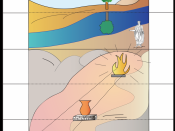"Reality is merely an illusion, albeit a very persistent one". These words, by Albert Einstein, beautifully sum up the Allegory of the Cave of Plato.
In Plato's cave, prisoners are chained facing a wall, they cannot see anything except the shadows on that wall which are being cast by objects placed in front of a fire. Those prisoners do not see the fire nor the objects. The shadows on the wall are their only "reality" and they have been exposed to this illusion all their life in a persistent and exclusive manner. I think the easiest and the most obvious analogy to make is that of today's mainstream televised media, for example, CNN news in the US. Most of the people in the US cannot see or experience events in other countries and they rely on CNN to get their information. Since they have been exposed to CNN all their life, and since CNN seems to report all domestic events accurately, this majority of citizens assume that CNN's reporting of foreign events must be similarly accurate, even though they have no way of verifying this accuracy.
In my opinion this is similar to the first stage of the Cave Allegory: "belief". Just like the prisoners in the cave believe that the shadows are real objects in their own sense, the viewers believe that the foreign news they see on CNN is the truth.
In the next stage, one of the prisoners breaks his chains and is able to turn around. He sees the fire and the objects casting shadows on the wall. He is deeply perplexed. Similarly, one of the viewers leaves the comfort of his couch and travels abroad; he is also perplexed when he notes discrepancies in CNN's reporting of foreign events. This discovery spurs a flurry...


